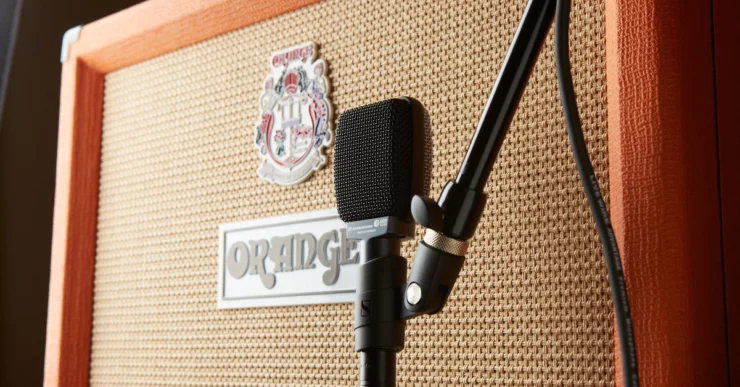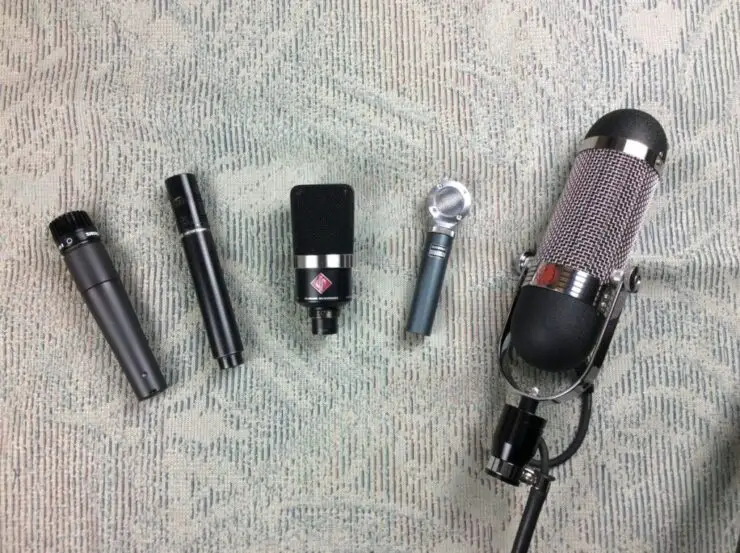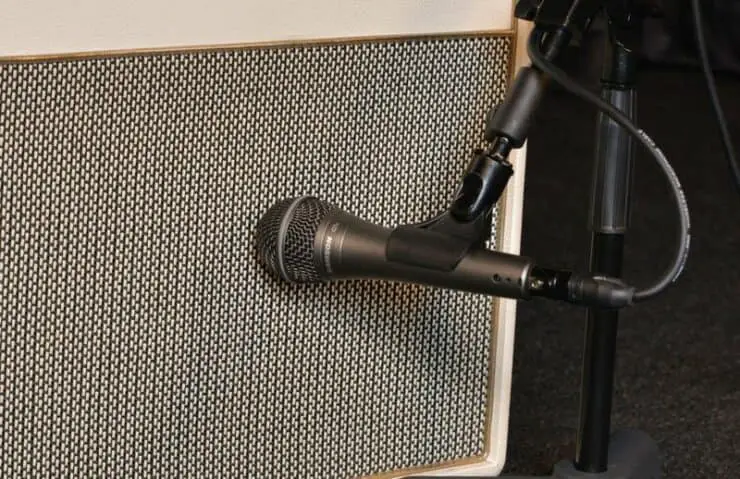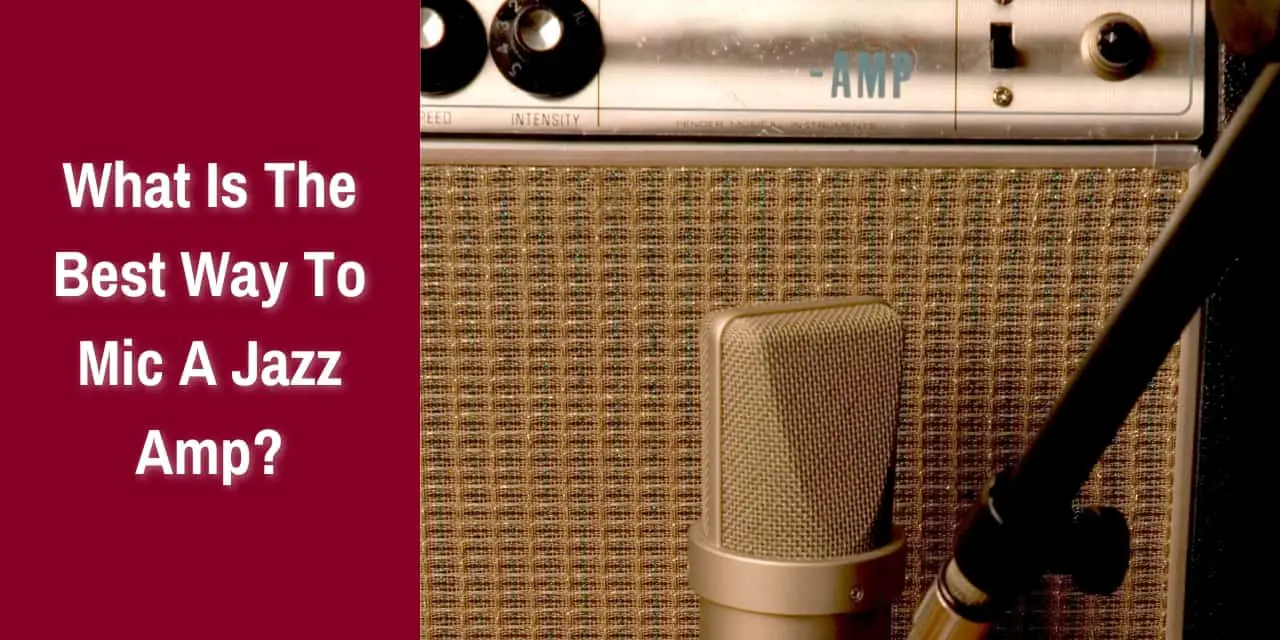Are you a jazz guitar player looking for the best setup to mic your amp? You’ve come to the right place! In this article, we’ll explore the ins and outs of miking a jazz amp for recording or live performance. We’ll cover different mic types, positioning techniques, and more – so read on to discover the best way to mic your jazz amp!
Definition of mic’ing a jazz amp
In the world of jazz music, it is important to capture the nuances and subtleties of your sound to deliver a rich and immersive experience. Whether you are a musician or a guitarist, you will need to know the significance of mic’ing a jazz amp. This process will involve placing microphones to capture the warmth, dynamics, and intricate tones of a jazz guitar amp.
Mic’ing or short for microphone placement is the practice of positioning microphones strategically for capturing sound accurately from a source. For jazz music, mic’ing a guitar amp will involve placing microphones near the amp’s speakers for capturing the amplified sound of the guitar. This process will allow for capturing the distinctive characteristics of the amp, the guitar, and the musician’s playing technique, creating a harmonious blend that defines this genre.
>>> Click here to read our review about the Top 15 Best Jazz Amps <<<
At its core, mic’ing a jazz amp largely revolves around capturing the sound waves produced by the guitar amp’s speakers. When the guitarist plays, the speakers vibrate, creating pressure waves in the air that carry the guitar’s unique tonal qualities and nuances. The microphone’s role is to convert the air pressure variations into electrical signals that can be recorded, amplified, or manipulated.

Microphones act as acoustic translators, converting the kinetic energy of sound waves into electrical energy. This conversion process involves a diaphragm, a coil, and a magnet to produce electrical output. The mic’s diaphragm is a thin, sensitive membrane that vibrates in response to changes in air pressure caused by sound waves. In dynamic and condenser mics, the diaphragm is a key player in capturing these vibrations.
Behind the diaphragm, there is a coil attached. When the diaphragm moves due to sound waves, it causes the oil to move within the magnetic field of a magnet. This motion generates a small electrical current. The generated electrical current is a direct representation of the sound waves hitting the diaphragm. The signal then gets sent through the mic’s cable to a preamp, mixer, or recording device for further processing.
Sound engineers often choose mics that complement the desired sound of the jazz guitar amp. Dynamics mics are commonly used due to their durability and the ability to handle high sound pressure levels, which are often encountered during live jazz performances. The placement of the mic plays a vital role in capturing the desired sound of the jazz amp. Different techniques will yield different results so choose according to your needs and preferences –
- Close mic’ing – Placing the mic close to the amp’s speaker will capture the immediate direct sound as this technique is ideal for capturing the amp’s specific tonal characteristics and nuances
- Off-axis mic’ing – Angling the mic away from the center of the speaker cone will soften harsh frequencies and provide a smoother and more balanced sound
- Room mic’ing – Positioning the mic at a distance from the amp can capture the ambient sound of the room, adding depth and natural reverb to the sound
As the jazz guitarist or musician plays, the microphone captures the sound of the amp, the guitar, and the player’s technique. When mic’ing a jazz amp, the ultimate goal isn’t to capture the literal sound of the amp but also to capture its soul and character. Jazz guitar playing is marked by its subtleties, dynamics, and expressiveness. The working mechanism of mic’ing a jazz amp aims to translate these elements, allowing listeners to experience the richness and artistry of jazz music. Essentially, you need to capture the full range of dynamics and tonal subtleties that make jazz guitar playing so unique.
After you have captured the sound, you can apply minimal processing to enhance the sound’s clarity and fidelity. The blended signals will then be mixed with other instruments and elements to create a cohesive jazz ensemble sound.
What is the best way to mic a jazz amp?
The art of mic’ing a jazz amp will require a delicate balance of technical expertise and artistic sensibility. From choosing the right mic to finding the ideal positioning, each step will play a pivotal role in capturing the nuanced and enchanting tones of a jazz guitar amp. This is where you might wonder what is the best way to mic a jazz amp. The method to mic a jazz amp is quite simple and straightforward if you know the rules. Here are the steps you need to follow for mic’ing a jazz amp, ensuring that you can create a captivating and authentic sound that embodies the essence of jazz music.
Step 1: Choose the right microphone
The first step in mic’ing a jazz amp will involve selecting the appropriate microphone that complements the desired sound. You need to consider the different options such as dynamic mics, condenser mics, and ribbon mics, and their characteristics.
Dynamic mics are robust and capable of handling high sound pressure levels, dynamic mics are perfect for capturing the warmth and dynamics of a jazz guitar amp. They offer a natural sound and are often used for close mic-ing to emphasize the amp’s tonal nuances.
Known for their sensitivity and precision, condenser microphones excel at capturing the intricate details of jazz guitar playing. They are amazing at capturing clean tones and delicate fingerpicking, offering a well-defined sound.
If you are looking for a vintage and smooth sound, ribbon microphones can be an amazing choice for jazz amp mic’ing. They add a touch of warmth and nostalgia to the sound but they require careful handling due to their delicate nature.
Step 2: Position the microphone
Once you have selected the appropriate microphone, the next important step would be to find the right placement for capturing the amp’s unique sound accurately. There are three routes you can take. It can be done either by close-mic’ing, off-axis mic’ing, or room mic’ing.
Close-mic’ing means placing the microphone around an inch or two away from the jazz amp’s speaker cone to capture the immediate sound and tonal characteristics. Experiment with different angles and positions for finding the sweet spot that captures the desired tone.
Off-axis mic’ing involves positioning the microphone slightly off-axis from the speaker cone. This softens harsh frequencies and captures a smoother sound. This technique is often used for mitigating the directness of the sound and creating a much more rounded tone.
Room mic’ing is done by placing the microphone at a distance from the amp to get a more ambient and spacious sound. This perfectly captures the sound of the room and adds a natural reverb, which can be especially effective for capturing the warmth of a jazz amp.

Step 3: Adjusting the gain
Adjusting the gain or microphone sensitivity is important for ensuring that the captured signal is neither too weak nor too loud. You need to start with the mic gain set to a moderate level. This will prevent distortion while ensuring that the signal is strong enough to capture the nuances of the jazz amp.
Have the musician or guitarist play a few phrases while you monitor the sound. Then, adjust the gain in real time for achieving a balanced and clear sound without any clipping or distortion. Leave some headroom by making sure that the loudest parts of the performance don’t cause the signal to clip. This will preserve the dynamics and prevent undesirable distortion.
Benefits of mic’ing a jazz amp
Jazz music is known for its intricate melodies, rich tonal textures, and improvisational spirit. This genre relies on the seamless blending of various musical elements for creating an enchanting auditory experience. Mic’ing a jazz amp is a technique that plays a key role in capturing the nuanced sound of the jazz guitar and contributes to the overall sonic palette of the genre. Mic’ing a jazz amp offers a wide range of benefits that you need to know about. Here are some of the benefits of mic’ing a jazz amp and how they elevate the way you play jazz music.
#1. Preserving authenticity
Mic’ing a jazz amp allows for the faithful reproduction of the original sound of the guitar and amp. Jazz guitarists often take pride in the distinct tone and nuances of their instruments and amplifiers. By placing the microphones near the amp’s speakers, the true essence of the guitar is captured, preserving the authenticity and uniqueness of the musician’s setup.
#2. Captured nuanced tone
Jazz guitar playing is characterized by its delicate touch, intricate phrasing, and dynamic range. Mic’ing a jazz amp allows you to capture the subtle nuances in your playing style. From the softest fingerpicked passages to the fiery crescendos, the microphones capture every detail, allowing listeners to appreciate the full scope of the musician’s expression.
#3. Tailoring sound to the venue
Jazz performances often take place in different venues, each with its own acoustic properties. Mic’ing a jazz amp offers flexibility in adjusting the guitar sound to suit the specific venue. Sound engineers can experiment with microphone placement and processing to ensure that the amplified sound blends seamlessly with the acoustics of the space, enhancing the overall listening experience for the audience.
#4. Control over the sound balance
In jazz ensembles, balance will be key. Mic’ing a jazz amp offers sound engineers precise control over the balance between guitar and other instruments. By adjusting the microphone levels and blending them with other instruments in the mix, engineers create a harmonious sonic balance that complements the overall ensemble sound.

#5. Customize sonic palette
Jazz guitarists often experiment with different amp settings, pedals, and playing techniques for achieving a particular sonic palette. Mic’ing a jazz amp will allow musicians to tailor their sound to fit the mood and emotion of their music. The captured sound can be enhanced further during mixing and post-production to achieve the desired tonal qualities.
#6. Enhancing live performances
Mic’ing a jazz amp isn’t just limited to studio recordings but it is equally valuable for live performances. By amplifying the sound of the jazz guitar, the musician’s expressive playing can reach every corner of the venue. This will allow the audience to fully immerse themselves in the intricate melodies and harmonies of jazz music, creating an intimate connection between performer and listener.
Different types of microphones for jazz amps
The world of sound engineering is a mix of intricate techniques and tools, each contributing to the creation of a rich and immersive auditory experience. When it comes to capturing the soulful melodies and electrifying tones of a guitar amp, the choice of the amp can make a difference. There are different types of microphones that offer diverse characteristics and nuances, shaping the sound of the guitar amp in unique ways. Here are the different types of microphones and their applications when capturing the mesmerizing sounds emanating from a guitar amp.
Dynamic microphones
Dynamic microphones are workhorses renowned for their durability and ability to handle high sound pressure levels. When mic’ing a guitar amp, dynamic mics are often chosen for their capacity to capture the raw power and intense tones produced by the amplifier. They are known for their durability, sensitivity, and natural sound. One of the most popular examples of dynamic mics is the iconic Shure SM57.
Dynamic microphones are robust and can withstand the rigors of close proximity to loud sound sources, making them suitable for capturing the loud and aggressive tones of distorted electric guitars.
They provide a natural and balanced sound, making them ideal for capturing the full frequency range of a guitar amp without exaggerating certain frequencies. They’re less sensitive than condenser mics, which means they’re able to handle high sound pressure levels without distorting, making them ideal for capturing loud guitar amplifiers.
Condenser microphones
Condenser microphones are known for their precision and sensitivity, making them an amazing choice for capturing the details of the jazz amp’s sound. Some of the key features of condenser mics include their sensitivity, high-frequency detail, and colorful sound.
Condenser mics are highly sensitive, which allows them to capture even the subtlest nuances in the guitar’s tone and the amp’s characteristics. These mics excel at capturing high-frequency details, which makes them ideal for capturing the shimmering harmonics and delicate intricacies of clean guitar tones.
Some condenser mics offer different polar patterns and tonal characteristics, allowing engineers to choose a mic that imparts a particular sonic coloration, enhancing the overall guitar sound.
Ribbon microphones
Ribbon microphones are well known for their vintage charm and warm, smooth sound reproduction. While they’re more delicate and need careful handling, they can offer a unique sonic quality when capturing jazz amps.
Ribbon mics offer a warm and vintage sound, often associated with classic recordings. They’re able to add a touch of nostalgia to modern guitar amp recordings. These mics have a smooth and natural roll-off in the high frequencies, which can help in taming harshness in guitar tones while providing a more pleasing tone.
They are quite delicate and sensitive to airflow, requiring proper handling and wind protection. However, their unique sonic character can make them worth the extra care.
Tips for capturing the perfect tone with a jazz amp
Mic’ing a jazz amp is a rather delicate endeavor that requires a blend of technical precision and an ear for nuance. Whether you are in the studio or on stage, capturing the intricate and expressive tone of a jazz guitar amp is an art form in itself. To take things up a level and capture the perfect tone from your jazz amp, you will want to take any help that you can. This is why you ought to know the tips and tricks to help you capture the sound that you’re looking for. Here are the tips you need to remember for capturing the perfect tone with a jazz amp. These tips are geared towards achieving a refined and sophisticated jazz tone that resonates with the genre’s elegance and artistry.
Know your sonic goals
Before you start mic’ing, have a thorough understanding of the sonic qualities you aim to achieve. Will you be going for a clean and crisp tone or do you just want to capture the warmth and richness of a slightly overdriven amp? Your sonic vision will guide your choices in microphone selection, positioning, and gain adjustments.
Use multiple microphones
Using multiple microphones offers greater flexibility and control over the captured sound, allowing you to blend different tonal qualities and achieve a more comprehensive representation of the jazz amp’s sound.
Employing a combination of a dynamic, condenser, and ribbon mic will provide a rich and textured sound that captures every aspect of the amp’s character. Each microphone type contributes its unique sonic signature.
You can explore and experiment with positioning different microphones at various distances and angles from the amp’s speaker cone. Blend the signals in the mix to craft a well-rounded sound that balances directness and ambient qualities.
Use a Direct Box (DI Box)
Integrating a direct box into the mic’ing setup can be especially useful for enhancing the sound quality and capturing a pristine signal from the jazz amp. A DI box will provide a balanced signal that can be sent directly to a recording interface or mixer. This will ensure a clean and noise-free signal, especially in situations where interference may affect the mic’ed signal.
Use both the mic’ed signal and the DI signal to get a layered sound. This approach will offer a safety net in case one signal suffers from unexpected issues, providing more options during mixing and post-production.
Use a preamp
A preamp can add warmth, color, and character to the mic’d signal, improving the sonic palette of the jazz amp. A preamp will allow you to shape the sound before it reaches the recording interface or mixer. You’ll be able to add subtle EQ adjustments, compression, and saturation to create a signature tone that complements the jazz guitar’s nuances.
Preamps often provide gain control, allowing you to easily adjust the signal level before it is sent to the recording equipment. This helps in achieving optimal levels and prevents clipping or distortion.
Trust your ears
Above all, you should trust your ears throughout this process. Listen closely to the sound and make adjustments based on what you are hearing. The nuances of jazz guitar playing will require attentive ears to capture the full spectrum of tonal subtleties.
FAQs
What is the best mic to use for miking a jazz amp?
Dynamic mics are typically the best choice for miking a jazz amp, as they can handle high sound pressure levels and offer good feedback rejection. Popular models include the Shure SM57, Sennheiser MD421, and AKG D112. A dynamic mic can also be used for miking a variety of other instruments, so it may be a good choice if you are looking for a versatile mic.
What placement should I use when miking a jazz amp?
When miking a jazz amp, it’s important to find the optimal placement to get the best sound. Generally, it’s best to place the mic between the center of the speaker cone and the edge of the cone, and angled slightly towards the center. This placement will capture the full range of the sound coming from the amp and minimize the risk of feedback.
What other considerations should I take when miking a jazz amp?
A: When miking a jazz amp, it’s important to consider the room’s acoustics. If the room has a lot of reverberation, it’s a good idea to use a mic with a cardioid polar pattern to reduce ambient noise. It’s also important to keep



